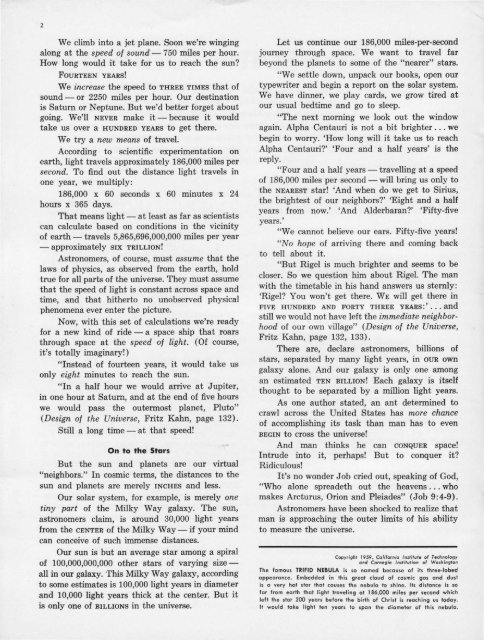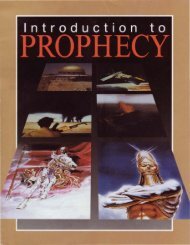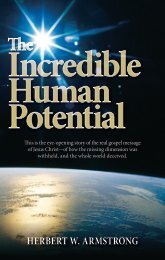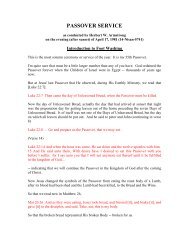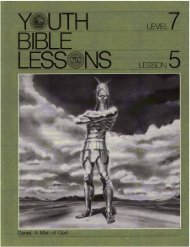Our Awesome Universe - Church of God - NEO
Our Awesome Universe - Church of God - NEO
Our Awesome Universe - Church of God - NEO
- No tags were found...
You also want an ePaper? Increase the reach of your titles
YUMPU automatically turns print PDFs into web optimized ePapers that Google loves.
2We climb into a jet plane. Soon we're wingingalong at the speed <strong>of</strong> sound - 750 miles per hour.How long would it take for us to reach the sun?FOURTEEN YEARS!We increase the speed to THREE TIMES that <strong>of</strong>sound - or 2250 miles per hour. <strong>Our</strong> destinationis Saturn or Neptune. But we'd better forget aboutgoing. We'll NEVER make it - because it wouldtake us over a HUNDRED YEARS to get there.We try a new means <strong>of</strong> travel.According to scientific experimentation onearth, light travels approximately 186,000 miles persecond. To find out the distance light travels inone year, we multiply:186,000 x 60 seconds x 60 minutes x 24hours x 365 days.That means light - at least as far as scientistscan calculate based on conditions in the vicinity<strong>of</strong> earth - travels 5,865,696,000,000 miles per year- approximately SIX TRILLION!Astronomers, <strong>of</strong> course, must assume that thelaws <strong>of</strong> physics, as observed from the earth, holdtrue for all parts <strong>of</strong> the universe. They must assumethat the speed <strong>of</strong> light is constant across space andtime, and that hitherto no unobserved physicalphenomena ever enter the picture.Now, with this set <strong>of</strong> calculations we're readyfor a new kind <strong>of</strong> ride - a space ship that roarsthrough space at the speed <strong>of</strong> light. (Of course,it's totally imaginary!)"Instead <strong>of</strong> fourteen years, it would take usonly eight minutes to reach the sun."In a half hour we would arrive at Jupiter,in one hour at Saturn, and at the end <strong>of</strong> five hourswe would pass the outermost planet, Pluto"(Design <strong>of</strong> the <strong>Universe</strong>, Fritz Kahn, page 132).Still a long time - at that speed!On to the StarsBut the sun and planets are our virtual"neighbors." In cosmic terms, the distances to thesun and planets are merely INCHES and less.<strong>Our</strong> solar system, for example, is merely onetiny part <strong>of</strong> the Milky Way galaxy. The sun,astronomers claim, is around 30,000 light yearsfrom the CENTER <strong>of</strong> the Milky Way - if your mindcan conceive <strong>of</strong> such immense distances.<strong>Our</strong> sun is but an average star among a spiral<strong>of</strong> 100,000,000,000 other stars <strong>of</strong> varying sizeallin our galaxy. This Milky Way galaxy, accordingto some estimates is 100,000 light years in diameterand 10,000 light years thick at the center. But itis only one <strong>of</strong> BILLIONS in the universe.Let us continue our 186,000 miles-per-secondjourney through space. We want to travel farbeyond the planets to some <strong>of</strong> the "nearer" stars."We settle down, unpack our books, open ourtypewriter and begin a report on the solar system.We have dinner, we play cards, we grow tired atour usual bedtime and go to sleep."The next morning we look out the windowagain. Alpha Centauri is not a bit brighter ... webegin to worry. 'How long will it take us to reachAlpha Centauri?' 'Four and a half years' is thereply."Four and a half years - travelling at a speed<strong>of</strong> 186,000 miles per second - will bring us only tothe NEAREST star! 'And when do we get to Sirius,the brightest <strong>of</strong> our neighbors?' 'Eight and a halfyears from now.' 'And Alderbaran?' 'Fifty-fiveyears.'"We cannot believe our ears. Fifty-five years!"No hope <strong>of</strong> arriving there and coming backto tell about it."But Rigel is much brighter and seems to becloser. So we question him about Rigel. The manwith the timetable in his hand answers us sternly:'Rigel? You won't get there. WE will get there inFIVE HUNDRED AND FORTY THREE YEARS:' ... andstill we would not have left the immediate neighborhood<strong>of</strong> our own village" (Design <strong>of</strong> the <strong>Universe</strong>,Fritz Kahn, page 132, 133).There are, declare astronomers, billions <strong>of</strong>stars, separated by many light years, in OUR owngalaxy alone. And our galaxy is only one amongan estimated TEN BILLION! Each galaxy is itselfthought to be separated by a million light years.As one author stated, an ant determined tocrawl across the United States has more chance<strong>of</strong> accomplishing its task than man has to evenBEGIN to cross the universe!And man thinks he can CONQUER space!Intrude into it, perhaps! But to conquer it?Ridiculous!It's no wonder Job cried out, speaking <strong>of</strong> <strong>God</strong>,"Who alone spreadeth out the heavens ... whomakes Arcturus, Orion and Pleiades" (Job 9:4-9).Astronomers have been shocked to realize thatman is approaching the outer limits ·<strong>of</strong> his abilityto measure the universe.Copyright 1959, California Institute <strong>of</strong> Technologyand Carnegie Institution <strong>of</strong> WashingtonThe famous TRIFID NEBULA is so named because <strong>of</strong> its three-lobedappearance. Embedded in this great cloud <strong>of</strong> cosmic gas and dustis a very hot star that causes the nebula to shine. Its distance is s<strong>of</strong>or from earth that light traveling at 186,000 miles per second whichleft the star 200 years before the birth <strong>of</strong> Christ is reaching us today.It would take light ten years 10 span Ihe diameter <strong>of</strong> this nebula.


